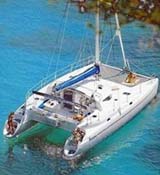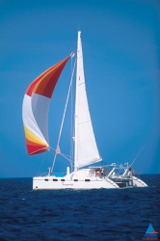Madagascar sits in the Indian Ocean about 250 miles off the east coast of Mozambique in Africa. It is the fourth largest island in the world. A yacht charter in Madagascar will give you access to calm turquoise waters, perfect for diving and snorkelling. The waters of Madagascar shelter an exceptional marine environment with remarkable varieties of coral and rainbow-coloured fish.
Madagascar offers a extensive range of yacht charter and this includes; bareboat yacht charter, luxury crewed yacht charter, skippered yacht charter, monohull and catamaran charter and both sail and motor yacht charter.
Madagascar is more a mini-continent than an island. There are six microclimates, which encourage an outstanding range of landscapes, flora and fauna. Many species on the island are found nowhere else in the world. The incredible number of unique species is due to the island's separation from the mainland about 165 million years ago and the relatively recent arrival of man only 2000 years ago. You will see dancing sifakas, singing indris, lemurs everywhere, dense rainforests, prehistoric spiny forests, avenues of baobabs, wild roses and trumpet lilies, neon coloured frogs, extra long chameleons, carnivorous pitcher plants.
The population of Madagascar is sparse and Afro-Indonesian in origin. There are said to be 18 different tribes, descendants of the Arabs, Indians, Africans, Chinese and Indonesians. Despite lying close to the coast of Mozambique, the people of Madagascar do not have much in common with those of Africa.
The first human settlers of Madagascar came from Asia, rather than Africa, between 100 and 500 AD. The settlement represented the western most branch of the great Austronesian expansion. The Malagasy language belongs to the group of Malayo-Polynesian languages, the rest of which are spoken in the island nations of Southeast Asia and the Pacific Ocean. In the 7th century Arabs established trading posts along the northwest coast of Madagascar. European contact began in the 1500s, when Portuguese sea captain Diogo Dias sighted the island. In the late 17th century, the French established trading posts along the east coast. From about 1774 to 1824, it was a favourite haunt for pirates.
France invaded Madagascar in 1883 seeking to restore property that had been confiscated from French citizens. The British accepted the imposition of a French protectorate over Madagascar in 1885 in return for eventual control over Zanzibar that is now part of Tanzania. In 1947 a nationalist uprising was suppressed after several months of bitter fighting. The French subsequently established reformed institutions and Madagascar moved peacefully toward independence. The Malagasy Republic was proclaimed on October 14, 1958, as an autonomous state within the French Community. A period of provisional government ended with the adoption of a constitution in 1959. Madagascar obtained full independence on June 26, 1960.
The international airport of Madagascar is located in Antananarivo and has several flights from Europe every week. Nosy Be has a small airport with daily flights to and from Antananarivo. The official language of Madagascar is Malagasy, although English and French are spoken widely. The Euro is the most common currency used in this region. The use of credit cards is very restricted.
Madagascar has a tropical climate. September, October and November are the best months to visit. The months of December to April have the most rain and will be very warm as the North Monsoon brings hot and humid air. Rain in heavy showers typically end quickly. However, North Monsoon is also the period during which Cyclones can develop. On average per year, the whole region sees 4 cyclones with winds of 65 knots and 10 tropical storms with winds between 35 to 65 knots. From April to December during the South Monsoon the southeast winds prevail. The South Monsoon Period is dryer and cooler than the North Monsoon. There are very strong winds in August during the tropical depression period. Winds can exceed 30 knots in the “funnel areas” north of the Mitsio Islands.
All visitors need a visa. You should also have the following vaccinations before travelling to Madagascar. DT polio, malaria, diphtheria, tetanus, hepatitis A and B. Malaria is a concern in Madagascar but mosquitoes are seldom seen when sailing and anchoring off shore. The World Health Organization does advise prophylactic medication. Only drink bottled water or take water purification tablets. Travel insurance is a very good idea for a yacht charter to Madagascar in case of emergency repatriation.
With bareboat yacht charters, a guide is usually included in the price of the yacht charter. Although not mandatory, he comes with the price and is essential for the many services he will provide. He will prepare the food, recommend good yacht anchorages and know where to fish and refill the boats water tanks. He will speak the local language and have an established relationship with the local people. He will protect the boat from theft when you leave it to explore on land. The guide lives completely on the exterior of the boat and does not require a cabin.
Once you embark on your yacht charter in Madagascar, there will be no further opportunities to provision again and you must live off the fish and seafood you will catch for yourself or with your guide. Take much care with your original provisioning list.
Yacht charters are concentrated on the volcanic island of Nosy Bé that lies off the northwest coast of Madagascar in the Mozambique Canal. Nosy Bé is the biggest and most populated of the Malagasy islands. Here are the most beautiful beaches shaded by coconut trees and washed by calm turquoise waters. Nosy Bé is renowned for its diving with multiple varieties of corals and multi coloured fish. The island is reputed for its fragrance, Nosy Bé is known as "The Fragrant Island". Numerous crops of ylang-ylang, coffee, sugar cane, and peppers are grown in large quantities and their scents fills the air.
A yacht charter from Nosy Bé will allow you to explore the nearby tiny islands that make this destination even more interesting. Just a few miles away to the south discover the turtle island of Nosy Iranja with its beautiful beaches and Nosy Komba where lemurs can be found. Also Nosy Tanikely, Russian Bay, Le Pain de Sucre or “sugar loaf”, Nosy Iranja, Nosy Radamas and Nosy Saba.
The Mitsios is an archipelago located 35 miles north of Nosy Bé. Here you will find warm, crystal-clear turquoise waters, deserted yacht anchorages and isolated villages. The Mitsios is particularly satisfying for tropical fish lovers and attracts divers from all over the world. The sea is teeming with fish and shellfish and lush, dense vegetation. The bright white, deserted beaches of these islands are made of fine bits of coral and shells. The archipelago is also defined by its remarkable rock formations: Cannes d’Orgues, a black, octagon shaped, basalt rock face and the Four Brothers, a group of rocks that stand out of the sea.
The Radames Archipelago lies 55 miles south west of Nosy Be. It is comprised of four coral islands; Nosy Kalakajoro, Nosy Ovy, Nosy Antany Mora and Nosy Valiha. Like the Mitsios, the underwater environment is absolutely enthralling for diving and snorkelling. This archipelago has lush tropical vegetation and deserted beaches. The few fishermen villages are known for their friendliness. They offer an opportunity to encounter a totally different way of life that has been untouched by time. The name people gave to their islands is very revealing: Nosy Kalakajoro means "the place where lives the joy" and Nosy Antany Mora means "the land where live the quiet people".
Tsara Banjina is 25 miles north of Nosy Be; enjoy its hotel and white sandy beaches and lush vegetation.
Efatra Zoky, four elders or the four cliffs, which are nesting places for gannets, have a magnificent marine life that attracts divers from all over the world.
















